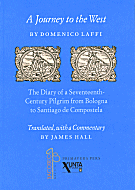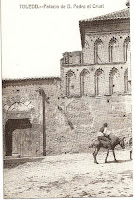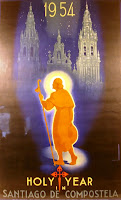14th October 2009 - Due to a corruption of some of the script, this post has been moved to:
http://amawalker.blogspot.com/2009/10/walking-in-winter.html
Welcome to my blog! I am a born-again walker and this is a journal of my wonderful walks. I'm planning on many more. “We are not human beings having a spiritual experience. We are spiritual beings having a human experience.” Teilhard de Chardin (amaWalkerscamino.com)
Saturday, October 25, 2008
Wednesday, October 15, 2008
BACK TO THE PAST

A friend who walked his 4th camino in September told me, “I don’t think I’ll walk that route
[the Camino
[the Camino
This set me thinking. 'What did it used to be like? It was a forgotten relic for almost 400 years and was only revived in the early 1980's, so what was it like before it died off?
What was the Camino Frances like in the middle ages?
Wasn’t it overcrowded and commercialised then too?
There are legends and urban legends about the numbers of pilgrims to Santiago de Compostela in the middle ages. Many are grossly exaggerated; some claim that over 500 000 pilgrims walked to
Documented numbers of pilgrims, and of hospices built to house them, provide some evidence of the popularity Santiago
How many pilgrims were there?
“.. in 1121, when Ali-ben-Yussef, the Almorávide, sent a deputation to Doña Urraca, the legates were amazed at the crowds of pilgrims who thronged the roads. They enquired from their escort in whose honor so great a multitude of Christians crossed the Pyrenees . “He who deserves such reverence,” answered the escort, “is St. James…” (Walter Starkie)
Research for the book “Jacobean Pilgrims from England to St. James of Compostella” by Constance Storrs showed that the majority of Jacobean pilgrims from England went to Spain
“From 1390 to 1399 pilgrims went every year in ships of West Country, south-or-south-east ports, the greatest number in 1395, a Jubilee Year. In the 15th-c the most favoured were the Holy Years of which three in particular, 1428, 1434 and 1445 had the heaviest traffic although in 1451, 1456 and 1484 pilgrims going by sea were still numerous … and, if the licence holders of these years did in fact carry full numbers .. some thousands of English pilgrims visited the apostle’s shrine in the 15th-c.” ²
16th-c
A register dating1594 at the hospice at Villafranca de Montes de Oca recorded 16,767 pilgrims that year, over 200 on some days.
17th-c
 “As late as the 17th-c, well into the decline of the pilgrimage, the
“As late as the 17th-c, well into the decline of the pilgrimage, the
(Canons of Roncesvalles - a monastery established to care for pilgrims in the 12th-c)
Growth from the 10th to 17th-c:
 As the number of pilgrims to Compostela increased, more and more refuges were established. In the 9th-c the majority were simple shelters attached to parish churches and provided floor space for small numbers of pilgrims. Royalty and wealthy families sponsored the building of many hospices, even in remote areas. At least four were established in Villafranca de Montes de Oca. Alfonso III built the Hospital de la Reina in 884. In 1270 Doná Vilonate founded another and Enrique’s queen, Juana Manuel, built another in 1380. It was improved and enlarged in the 15th-c. Pilgrims brought prosperity and entire villages, such as Estella, were established as a result of the pilgrimage. Shops, markets, manufacturers, artisans, inns, taverns and all sorts of traders benefited from the rise in pilgrim numbers.
As the number of pilgrims to Compostela increased, more and more refuges were established. In the 9th-c the majority were simple shelters attached to parish churches and provided floor space for small numbers of pilgrims. Royalty and wealthy families sponsored the building of many hospices, even in remote areas. At least four were established in Villafranca de Montes de Oca. Alfonso III built the Hospital de la Reina in 884. In 1270 Doná Vilonate founded another and Enrique’s queen, Juana Manuel, built another in 1380. It was improved and enlarged in the 15th-c. Pilgrims brought prosperity and entire villages, such as Estella, were established as a result of the pilgrimage. Shops, markets, manufacturers, artisans, inns, taverns and all sorts of traders benefited from the rise in pilgrim numbers.
Hospices - pilgrim shelters
 In the middle ages almost every town and village on the Camino Frances supported at least one pilgrim hospice. Many were small - a favourite number was 12 beds that corresponded with the numbers of apostles.
In the middle ages almost every town and village on the Camino Frances supported at least one pilgrim hospice. Many were small - a favourite number was 12 beds that corresponded with the numbers of apostles.The town with the highest number was
Astorga had 21, Carrion de los Condes had 14 and at one time there were 7 in Castrojeriz. Even small villages like Obanos and Viana had several pilgrim shelters. Terradillos de los Templarios and neighbouring Moratinos were among the few pueblos that did not provide a hospice for pilgrims.
Just as they are today, some hospices were provided by Confraternities, some by the church and some were privately run.
How many hospices were there?
It is not possible to know how many hospices existed at any one time on the Camino Frances. Numbers fluctuated between the 10th and 15th centuries. By adding up all the hospices actually mentioned in the books The Road to Santiago by Gitlitz and Davidson and The Pilgrim’s Guide to Santiago de Compostela by Annie Shaver-Crandell and Paula Gerson, we know that by the 15th-c there were at least 161. One would have to make a few assumptions regarding the others. Gitlitz and Davidson say that in some villages there were, “… several pilgrim hospices” and that others had, “…. many pilgrim hospices.”
Towns that had ‘several’ or ‘many’ include Pamplona (at least 6), Obanos, Estella (about 11), Logrono , Najera, Sahagun (4 in the late 15th-c), Puente de Villarente , Leon (many), Portomarin and Santiago
One can reasonably estimate that in the middle ages, at the height of the popularity of the pilgrimage to Santiago
(As of June 2008 there are about 130 albergues (Red de Albergues 2008 Brochure.)
The decline of the pilgrimage
In 1589 the relics of the saint were moved and hidden from a possible attack by Frances Drake – and were then forgotten for almost 300 years! It’s not surprising that the number of pilgrims to
An occasional foreign pilgrim still walked to Compostela and some wrote about their journeys. Domenico Laffi, an Italian priest walked from his hometown in Bologna  lian, Nicola Albani, walked from
lian, Nicola Albani, walked from Genoa
 lian, Nicola Albani, walked from
lian, Nicola Albani, walked from
“In the 17th century, the Spanish national cult of Santiago experienced a crisis when it was challenged by that of saint Teresa of Avila , a hugely popular 16th century mystic St. James remained the patron of Spain, but the quarrel left the cult much weakened. In late 17th century, the pilgrimage experienced something of a revival and reached a new (if more modest, honestly religious) peak, but mid-18th century again saw a marked decline. The scientific and industrial revolution in 19th century also rendered the pilgrimage obsolete in the rest of Europe .” Antti Lahelma
19th-c
The Spanish Civil war of 1820 – 1823 further prevented pilgrims from visitingSantiago
The Spanish Civil war of 1820 – 1823 further prevented pilgrims from visiting
“In the Holy Year of 1867 just 40 pilgrims turned up for the celebrated mass on 25th July.” ³
A sear ch for the relics was launched in 1879 and they were eventually found between the walls of the apse. “A papal bull from Pope Leo XIII (in 1884) declared them to be genuine in order to silence sceptics.” ³
ch for the relics was launched in 1879 and they were eventually found between the walls of the apse. “A papal bull from Pope Leo XIII (in 1884) declared them to be genuine in order to silence sceptics.” ³
 ch for the relics was launched in 1879 and they were eventually found between the walls of the apse. “A papal bull from Pope Leo XIII (in 1884) declared them to be genuine in order to silence sceptics.” ³
ch for the relics was launched in 1879 and they were eventually found between the walls of the apse. “A papal bull from Pope Leo XIII (in 1884) declared them to be genuine in order to silence sceptics.” ³
A New York Times article describes the 15th August 1965 Holy Year celebration.
“.. hundreds of pilgrims including scores of priests in black cassocks lining up in the Obradoiro square.. The worshippers who stream into Santiago by bus and car … The 50 miles of road from La Coruna
It was mainly art historians who showed interest in the old pilgrimage  roads to Compostela. Georgiana Goddard
roads to Compostela. Georgiana Goddard  King published her book, “The Way of St James”, in 1920. This book in turn inspired Walter Starkie to make 4 pilgrimages to
King published her book, “The Way of St James”, in 1920. This book in turn inspired Walter Starkie to make 4 pilgrimages to Santiago
 roads to Compostela. Georgiana Goddard
roads to Compostela. Georgiana Goddard  King published her book, “The Way of St James”, in 1920. This book in turn inspired Walter Starkie to make 4 pilgrimages to
King published her book, “The Way of St James”, in 1920. This book in turn inspired Walter Starkie to make 4 pilgrimages to
In 1937 Sant’Iago was officially restored as the patron saint of Spain
The modern pilgrimage - 20th-c
The modern pilgrimage, as we know it, really only started in the 1970’s although a motorised pilgrimage was promoted in the Holy Years starting in 1954, complete with a credencial and a diploma at the end.
David Gitlitz’s imagination was fired by Walter Starkie’s accounts of his pilgrimage experiences. When Linda and David walked the old pilgrimage paths across
The numbers of pilgrims who have received the Compostela increased from about 6 in 1972 to 114 000 in 2007. This was the highest number of pilgrims, outside the Holy Years, since the reanimation of the pilgrimage in the early 1980’s.
(This number does not include the many thousands who walk short sections of the various camino roads during their holidays and do not receive the Compostela certificate.)
The reanimation of the route from Roncesvalles to Santiago can be attributed to D Elias Valeno Sampedro, the parish priest of O Cebreiro who devoted his life to rediscovering the old ways.
" In the 1970’s there survived only a remote memory of the Jacobean pilgrimage” he wrote. In 1971 he wrote the book ‘Caminos a Compostela’."
Don Elias’ guide was published in 1982 and at a gathering in Santiago
Back to the Past
The roads to Santiago
Another important feature that helped to keep the phenomenon of Jacobean pilgrimage alive was hospitality, which on the Way of Saint James involved both rich and poor. The practice of hospitality led to the founding of welfare institutions that attended to the spiritual, material and health needs of the pilgrims. According to their ecclesiastical, civil or popular origins, the centres can be classified as episcopal or cathedral hospitals, hospitals run by the military, monastic or royal orders, noble foundations, parish hospitals, and in the cities along the Way, hospitals run by guilds and religious brotherhoods. Especially important in this respect were the monasteries of Cluny and the military orders, especially the Knights Hospitaller. (Xacobeo.es)
Competition in commerce and industry flourished and there was a vibrant tourist industry.
“In medieval times the Compostela tourist industry pitched its wares in Lavaolla. Documents tell us that just like today’s merchants, 12th-c Compostelans posted advertisements, in a variety of languages, touting the virtues and prices of their inns, restaurants and taverns.” ¹
The Galician Xunta expects to host over 10 million visitors to Santiago
Perhaps el Camino is becoming exactly as it used to be in the middle ages!!
1. The Road to Santiago
2. Jacobean Pilgrims from England
3: Camino de Santiago - Cordla Rabe, Rother Walking Guide.
4. The Pilgrim’s Guide to Santiago de Compostela” - Annie Shaver-Crandell and Paula
Gerson
Labels:
Camino,
camino frances,
Georgiana King,
pamplona,
Pilgrims,
Santiago,
Santiago de Compostela
Wednesday, October 01, 2008
COMMUNICATING, BLOGGING AND POSTING PHOTOS ON THE CAMINO
STARTING WITH PHOTOS:
It isn't always easy to post photos onto a blog when you are walking the camino. Although there are internet facilities in many towns and villages, in cafe-bars, albergues and municipal libraries, some machines are old and very slow whilst others don't have the technology.There are a few gadgets that can help.
ACCSTATION sells a Memory Card to USB adaptor for $5.39.
- This USB SD/MMC memory card reader is the ideal companion for your digital media. Avoid the hassle of carrying a bulky card reader in order to transfer photos, music, data and more between PCs.
- Ideal for portable use on the road or at home with a desktop or laptop. Your data and pictures can be instantly transferred to your PC/Notebook.
- Instantly convert your SD/MMC cards into a USB Flash Drive.
Read Evan's blog for more info on blogging and posting photographs.
*****************************************************************
Blogging - How easy is it on the camino? A guide to blogging from the Camino by John Misfud and Evan http://la-via-lattea.blogspot.com/ http://camino.wificat.com/
*******************************************************************
Veteran pilgrim and WanderingTheWorld blogger, Jim Damico, guest posts on another moBlogging option: Pocketmail*.
Jim describes a simple-to-use mobile emailing device which might provide the perfect solution for those who wish to blog on the go from the Camino but find the prospect of dealing with the technology and price of a smartphone daunting.
An update from Jim:
Pocketmail is definitely much easier to use than trying to find an internet cafe (or at least one that doesn't have a dozen of peregrinos already waiting to log on). You pay about $99 for the device which is pretty easy to learn, definitely not complicated. And while using it, you pay about $13 a month for the service. In Europe, they give you phone numbers in a few major cities in each country that you dial-up to send and receive email. On my travels, a typical download/upload of email lasted at most 20 seconds. So, a pretty cheap phone call.***********************************************************************
I just finished a trip biking across Canada and I took my laptop instead. What a lot of work! I really should have brought my Pocketmail. At first I didn't think their would be enough pay phones (as they are disappearing fast in the USA) but every little town in Canada had a pay phone so the Pocketmail would have been ideal. Lesson learned.
PHONING HOME
Cell phones/Mobiles: Orange
service in Madrid , run by an American/Scottish expat has been recommended. He can set you up with a mobile phone at the best price available, and have it waiting for you when you arrive in Pamplona or Leon  His name is Jer, you can find him and his business at http://www.multimadrid.com/.
His name is Jer, you can find him and his business at http://www.multimadrid.com/.
 His name is Jer, you can find him and his business at http://www.multimadrid.com/.
His name is Jer, you can find him and his business at http://www.multimadrid.com/. If you do take your mobile/cell phone, take an adaptor plug for Spain and a USB reader for the phone memory card so that you can post pictures onto your blog.
If you don't want to carry a cell phone you can buy a World Call card before you leave home. When using phone cards, its often half the price if you use the yellow and blue phones inside the bars and not the Telefonica Call boxes on the streets.You can also buy cards very cheaply in Spain to make international calls.
Labels:
Camino,
camino frances,
el camino,
Pilgrimage,
Pilgrims,
Santiago,
Santiago de Compostela
Subscribe to:
Posts (Atom)






